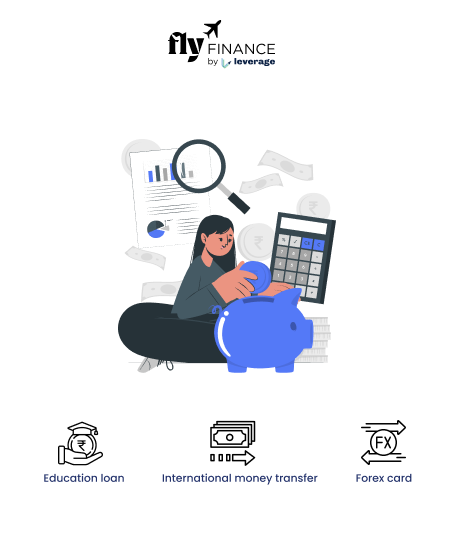Are you someone who is finding it difficult to navigate through the jargon-filled education loan process? Does it happen to you that every time you research lenders for an education loan, you come across different daunting terminologies? If the answer to these questions is yes, then worry not! You are not the only one who is feeling overwhelmed by all these complex words. A lot of aspiring international students like you face these challenges when they begin their study abroad journey.
To make your education loan process simple and convenient, we have prepared a comprehensive list of terms related to education loans. You’ll come across some of these words right when you begin your journey and some when you start repaying your loans. Whichever is the case, keep this list handy and come back to refer to it whenever you find a difficult term. So, let’s dive right in and learn about the meanings of these words!
Table of contents
You must have come across two important types of education loans – secured education loans and unsecured education loans. Let’s learn about the meaning of these terms.
- Secured education loans: Secured education loans are the type of education loans where you are required to pledge collateral/security. Both government and private banks provide such types of loans but they all demand collateral security from the borrower. And, in case the borrower fails to repay the loan, then this collateral is forfeited by the lender.
- Unsecured education loans: Unsecured education loans are education loans without collateral. It becomes mandatory for borrowers to also take education loan insurance while taking unsecured education loans from NBFCs and private banks.
Basic Education Loan Terms
There are some basic education loan terminologies that you might already be aware of. However, you must check all the terms mentioned below as you might come across them sooner or later when you apply for education loans.
- Principal: Principal is the original loan amount that you receive from your lender. When you apply for an education loan, the complete loan amount granted by the financial institution is known as the principal.
- Interest rate: It is the money paid to a financial institution by a borrower for borrowing the loan. For example, if you take an education loan of INR 7.5 Lakhs at 12% for 10 years, then 7.5 Lakhs is your principal amount and the interest rate is 12%.
- Collateral: Collateral is an asset that a borrower mortgages to a financial institution. It can either be a liquid asset or an immovable property. In case, the borrower is unable to pay the loan, then this collateral is forfeited by the lender. Some examples of collaterals include an apartment, non-agricultural land, fixed deposits, etc.
- Credit score: A credit score represents a person’s creditworthiness. Lenders usually check this score when you apply for an education loan. A good credit score can increase your chances of getting a loan approved. Usually, a score above 650 is considered a good credit score.
- Debt-to-income ratio: Just like a credit score, a debt-to-income ratio is used to assess a borrower’s repayment capacity as per income. It is a ratio that compares a borrower’s total existing monthly debt payments to their total monthly income. By looking at the ratio, the lender will assess whether you will be able to manage your monthly payments or not. A lower debt-to-income ratio increases your chances of getting a loan approved.
- Co-applicant: A co-applicant also known as a co-signer or a co-borrower is a person that signs the education loan agreement with the main borrower. A co-applicant is liable to repay the education loan in case the main borrower is unable to repay it. For example, if you take an education loan then you will be considered as the main borrower and your parents can become your co-applicant.
- Guarantor: A guarantor is a third party who attests that the borrower will repay the loan amount and in case of default by the borrower, the guarantor is liable to repay the loan.
- Loan margin: Loan margin is the amount of money paid by the borrower for financing their education. The loan margin is paid by the borrower and is not covered by the financial institution. It is also known as a ‘down payment’. For example, if you applied for an education loan for INR 7.5 Lakhs but the lender has sanctioned only INR 7.3 Lakhs, then INR 20,000 is the loan margin and you have to arrange it on your own. The loan margin is usually expressed in percentage and in the above example the loan margin would be around 2.67%.
- Loan tenure: Loan tenure also known as ‘loan duration’ is the total duration of the loan repayment. The EMIs are fixed based on the repayment period. A long-term loan usually attracts more cost as compared to a short-term loan.
- Processing fee: The processing fee is a one-time charge that you have to pay to your lender for processing and sanctioning your loan. This fee varies from lender to lender and can either be a fixed amount or a percentage of the loan amount. It is not always necessary for you to pay this fee, in some cases, banks do not charge any processing fee at all.
- Loan sanction: After you have submitted your documents, the financial institution verifies them. If your documentation meets their requirements your loan is sanctioned, and this is what loan sanction means.
Specific Terms Used For Interest Rates
There are also different types of interest rates and some specific terms related to them such as:
- Floating interest rate: A floating interest rate refers to interest rates subject to revision every quarter. If the inflation rates are higher, the interest on your education loan will increase and the EMI will also be revised accordingly. Your education loan can either come with a floating interest rate or a fixed interest rate and you should check this with your bank while applying for an education loan.
- Fixed interest rate: Fixed interest rates refer to those interest rates that do not change during the entire loan repayment period.
- Accrued interest: Accrued interest is the interest amount that has been charged by the bank but has not been paid by the borrower. For example, if you have availed of the moratorium period and you are not paying EMIs, the interest charged during that period will be called the accrued interest.
- Marginal Cost of Funds-based Lending Rate (MCLR): In simple terms, MCLR is the minimum lending rate below which a bank is not permitted to lend. It is the benchmark value based on which the education loan interest rates of most Indian lenders are fixed.
When you finally start repaying your loans, you’ll need a basic understanding of the below-mentioned terms. These terms are definitely going to help you make informed decisions and understand your loan repayment process better:
- EMI: EMI stands for Equated Monthly Instalments and is an effective method of repaying any loan in regular monthly instalments. It is a fixed amount of money that is paid every month and includes both the principal amount and rate of interest. You can use an Education Loan EMI Calculator to calculate your monthly EMIs.
- Moratorium period and Grace period: The moratorium period also known as the ‘grace period’ is the period when a student is not required to make any repayments for the loan. This period typically spans the course duration and some additional months after completion. However, the interest will be charged by the bank for this period.
- ECS/ACH mandate: ECS stands for Electronic Clearing Service, while ACH stands for Automated Clearing House. These are electronic payment systems that allow you to pay recurring expenses or payments automatically on the chosen date. The payment is auto-debited from your account with prior authorization.
- Standing instruction: Standing instruction means giving instructions to your bank to make an automatic payment of a fixed amount at regular intervals by debiting the amount from your account.
- Bounce charges: If you plan to repay the loan through cheque or other electronic means but if the payment bounces due to lack of sufficient funds in your account then you’ll have to pay some penalty which is known as a bounce charge.
- Foreclosure: A foreclosure is simply the closing of an education loan by paying off the entire amount borrowed in one lump sum amount before the repayment period ends.
- Prepayment charges: Prepayment charges are levied whenever the borrower wants to repay and close the education loan account before the agreed-upon tenure.
Also Read: Are you aware of the hidden charges on your education loans? If not, then you must read this blog about the same: Unveiling the Hidden Charges of Education Loans: What You Need to Know
Below is a list of a few miscellaneous words, some of which are also options that students take in different scenarios during their study abroad journey. Let’s take a look at each of these words:
- Loan refinancing: Loan refinancing refers to the process of taking a fresh loan at a lower interest rate from the same or new lender and foreclosing the ongoing loan.
- Loan consolidation/ Debt consolidation: Loan consolidation, commonly known as debt consolidation, is the process of converting multiple loans into a single one.
- Top-up loan: Top-up loan is the loan provided on the existing education loan to students interested in pursuing further studies. The process of applying for a top-up loan is generally easier and quicker than applying for a new loan.
- Education loan insurance: Education loan insurance is a financial tool to reduce financial pressure on the co-applicant in case the borrower suffers a misfortune or terminal illness. The term implies taking insurance on your education loan which basically means that in case the borrower fails to repay the loan due to death or terminal illness then the liability to repay the loan will shift from the co-applicant to the insurance company.
- Loan amortization: Loan amortization is the process of paying the loan, including the interest rate over time in regular instalments as per the amortization schedule.
- Loan disbursement: Loan disbursement is the process by which the lender transfers the loan amount to the borrower.
- Pre-Visa disbursement: Pre-Visa disbursement loans are given out so that students can secure their seats by making an initial deposit or first-semester tuition fee payment to the university/college before they get their Visa.
- Post-Visa disbursement: Post-Visa disbursement loan is given after students get their Visa approval.
Also Read: If you want to know how a loan sanction letter is different from a loan disbursement letter then you must read our blog on the same: Difference Between Loan Sanction Letter and Loan Disbursement Letter
FAQs
A collateral is an asset that a borrower mortgages to a financial institution. In case, the borrower is unable to pay the loan, then this collateral is forfeited by the lender. Some examples of collaterals include an apartment, non-agricultural land, fixed deposits, etc.
A loan foreclosure is simply the closing of an education loan by paying off the entire amount borrowed in one lump sum amount.
A fixed interest rate remains constant throughout the loan tenure, while a floating interest rate changes as per market conditions and is subject to revision every quarter. The advantage of fixed interest rates is that they provide stability but floating interest rates being flexible in nature may offer lower interest rates.
This blog covered some terminologies related to the education loan process. If you know these words, it will certainly help you in making informed decisions during your study abroad journey. Though we have tried our best to make this list as comprehensive as possible, if you come across any new terms then feel free to mention them in the comments section. Happy learning!
To know more about the education loan terminologies, the best international bank accounts for students, forex and banking experience for global students or international money transfers, reach out to our experts at 1800572126 to help ease your study abroad experience.
Follow Us on Social Media





























